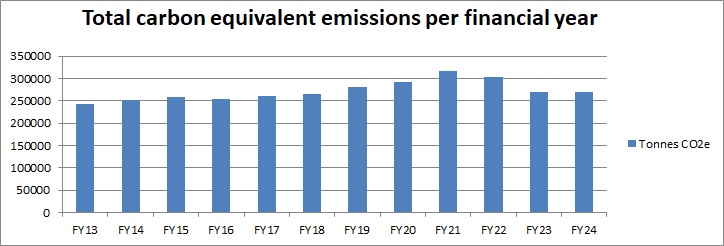Consistent with our Environment and Sustainability Policy, Queensland Rail engages in proactive management to manage our environmental impacts and maintain compliance with applicable environmental legislation.
Queensland Rail maintains a documented Safety and Environmental Management System to communicate environmental and sustainability requirements to staff. These requirements include pollution control, weed and pest management, sustainable design principles, and managing impacts from construction and maintenance activities.
Energy and Emissions
As a large energy user, Queensland Rail seeks to manage energy efficiently and progress practicable opportunities for improvement.
Queensland Rail monitors its energy use and emissions and provides annual reporting to the Federal Government as per the National Greenhouse & Energy Reporting Act. The following chart shows Queensland Rail’s reported annual carbon emissions.

The largest portion of Queensland Rail’s carbon emissions arise from the supply of traction electricity to our electric trains.
To help keep our energy and emissions on track:
- Train movements including energy use are extensively modelled.
- Many of the trains operated by Queensland Rail, including all New Generation Rollingstock, utilise regenerative braking which feeds electricity back into the traction network.
- Some of our electricity contracts include renewable energy and we have renewable generation at some of our locations.
- Queensland Rail also seeks to improve energy efficiency throughout design of new, and upgrades to existing, assets and infrastructure.
- We are actively exploring and monitoring technologies, innovations and processes that may support our emissions reduction ambitions.
Over recent years we have added additional services to our network. It is important to recognise that rail is a key part of a sustainable transport system, and provision of additional rail services increases the availability of rail as a transport option for our customers, supporting an efficient transport sector.
Vegetation Management
Queensland Rail manages vegetation to ensure the safety and reliability of our operations, whilst also supporting environmental outcomes where possible.
Regular vegetation maintenance is undertaken to ensure the safe and reliable functioning of the network, the protection of assets and the safety of customers, workers and the community. If not managed effectively, vegetation may reduce visibility of safety critical signage and signals, increase risk of wildfire, or damage rail infrastructure including electric traction infrastructure.
As an electrical entity under the Electrical Safety Act 2002 Queensland Rail has obligations to ensure electrical safety, and an important component of this is managing vegetation within and near electric traction infrastructure. Trees and other vegetation must be prevented from encroaching within the electrical clearance space. Regular maintenance is conducted across our network to manage this risk.
Inappropriate plantings on neighbouring properties can impact the integrity of rail infrastructure, including electric traction infrastructure. Large trees and palms, bamboo and some vigorous climbers are not appropriate as they can pose a significant risk to the rail network.
Queensland Rail encourages neighbouring properties to refer to and follow the excellent guidance provided by Energex and Ergon Energy when selecting suitable plants for use near electric traction infrastructure.
For neighbours in South East Queensland - access information on Energex's Safetree initiative via the Plant Smart webpage including the Plant Smart Search. For neighbours north of Gympie – refer to the Ergon Energy Plant Smart webpage. These websites provide lists of suitable powerline friendly trees for your local Council area.
Queensland Rail also recognises the benefits of vegetation for wildlife conservation and habitat provision and connectivity, erosion control and bank stability, and for shade and amenity for our neighbours and customers. We encourage the retention and protection of appropriate vegetation where possible.
Weed and Pest Management
Ongoing maintenance occurs in our rail corridors to identify, monitor and treat weeds as required.
Pest animal control occurs as needed to prevent high priority pest animal infestations. Vegetation management occurs to prevent the harbourage of pest animals on the rail corridor as applicable.
Queensland Rail often works in partnership with adjacent landholders, Councils and other State government agencies to coordinate the control of weeds and pests in a collaborative manner. This approach helps to prevent weeds and pests from establishing or spreading along the rail network or on neighbouring properties.
Waste Management
Queensland Rail is committed to managing its waste responsibly. All waste is disposed of by licensed waste contractors.
Waste is recycled where possible, including scrap metal, timber, paper, industrial waste, waste oils, as well as some hazardous waste. Public recycling bins are available at some stations.
Ballast spoil generated through track maintenance works is managed to
maximise landfill diversion and beneficial reuse where possible. In SEQ recycling rates can be upwards of
90%.